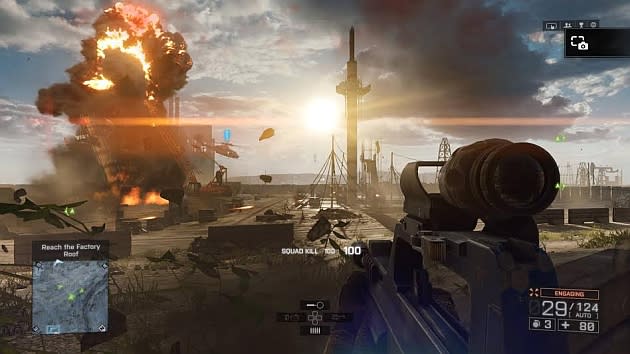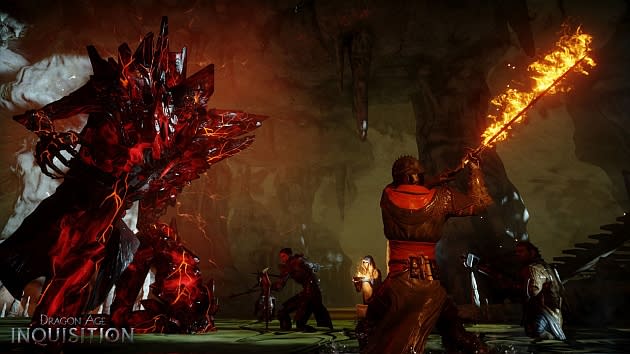From Battlefield to Mass Effect: How one engine is shaping the future of EA Games

After crossing under the elevated railroad viaduct that bisects a lush Azerbaijani forest from an industrial landscape, a squad of American soldiers gazes out at the valley that lies below. A saw-toothed horizon of half-assembled buildings juts out in the distance. It's almost peaceful. Hundreds of seagulls chatter lazily overhead, blissfully unaware that the ensuing firefight will leave the seemingly forgotten structures looking somehow even worse for wear. Whole facades crumble under the hellfire of a military attack chopper. A grenade launcher's explosive payload immediately contradicts the seemingly harmless thud it makes upon exiting the weapon's chamber. An enemy scrambles for a new safe haven; his earlier hiding place no longer exists. By scene's end, all that's left are roiling flames and caustic black smoke.
This scene from the Battlefield 4 trailer was how the world, perhaps unwittingly, met Frostbite Engine 3, the next-gen toolset powering all of Electronic Arts' non-sports games for the foreseeable future.
Soon after Battlefield 4's debut, EA announced that it was moving away from a fragmented development system where seemingly every studio used a different toolset to create its games, and would use Frostbite, the publisher's proprietary game engine, instead. The move could benefit the financially beleaguered publisher by eliminating licensing fees for third-party tools like the ubiquitous Unreal Engine. Gamers, however, stand to reap the biggest rewards, with the promise of higher-quality games for their new consoles.
A disposable history
To understand how EA got to this point, you have to take a trip back to 2006, when its Swedish developer Digital Illusions Creative Entertainment (now known as DICE) announced Battlefield Bad Company. Not only did that game shift away from the previously PC- and multiplayer-only offerings that came before it (Battlefield 1942, Battlefield 2 and Battlefield 2142) and include a narrative single-player campaign, it was developed exclusively for the PlayStation 3 and Xbox 360. Beyond that, it was also the first of many games DICE produced on Frostbite, as opposed to starting from scratch with a new engine for each title. At its most basic level, a game engine is the end-to-end software suite that a developer uses to create a game's graphics, physics, sound, artificial intelligence and whatever else the title demands. Like a car's motor, it's the heart of what pushes the game down the road.
"We'd built a completely new engine for Battlefield 2 and were on our way to building another new engine again [for our next project]," said Patrick Bach, executive producer on Battlefield 4. "We'd had some brilliant engines in the past, so it was about merging them into one engine, and that's kind of where the first Frostbite Engine sprang from."
With the first version of the engine complete, the team was able to use it as the foundation for the toolset's next phase. Each year following Bad Company's 2008 release saw a new game in the franchise and marked improvements in Frostbite's audio, gameplay and visuals. By 2011's Battlefield 3, DICE had overshadowed its previous technical achievements by orders of magnitude. Animations were incredibly smooth and lifelike. On the PC, its graphics had reached a point of nigh-photo-realism and the way levels broke apart over the course of a firefight, or even a natural disaster, all but telegraphed the studio's next-gen console strategy.
Meanwhile, at Electronic Arts HQ
Around this time, the EA Games label -- made up of internal non-sports developers -- had 11 different engines powering its games, and with each release, it became clearer that this fragmented ecosystem wasn't feasible anymore.
"Frank Gibeau (now-EVP of EA Mobile), myself and others said that this has to stop; this has to get a unified platform because it's too expensive and inefficient for everyone to be operating off of different engines," Patrick Soderlund, EVP of EA Studios told us.
Instead of strong-arming developers into using the engine with a company-wide mandate, Soderlund wanted to take a different route. "We'll produce great games on it, games that look good and we think are developed in the proper way, and then hopefully if people will want to use it, they're going to come and ask for it," he said.
That's exactly what happened. BioWare reached out to EA about using the engine for the next games in its Dragon Age and Mass Effect role-playing franchises. Next came Ghost Games, which developed the latest entry in the Need for Speed franchise, Need for Speed Rivals. More developers followed. There are now more than a dozen Frostbite-powered games in the works, ranging from a new Mirror's Edge to the next Star Wars: Battlefront and a slew of unannounced projects. With the staggering progress that DICE made with Frostbite 3, it's easy to see why it was more or less handpicked to power EA's next-gen titles. "[Frostbite 3] is a total package when it comes to being not only a Battlefield engine, but [also] a game engine," Bach said.
What's mine is mine
EA is keeping its new toy close to its chest, though. None of its third-party partners are using it at this point, and that goes for Respawn Entertainment and Crytek, each of whom are using proprietary software to create their next games. Soderlund said the engine wouldn't be a generic tool licensed out to external developers, like Epic's Unreal Engine. He sees this as something of a leg up on the competition.
"If you look at the magnitude and complexity of a Battlefield game – using Battlefield 4 as an example – you can see that you can build pretty much everything with this engine to a very, very high quality"
"We see it as an internal advantage, and we want to keep that inside our walls," he said. If an outside studio pitched EA on a project that EA would publish, though, Soderlund said that could happen. The situation just hasn't come up yet.
The closed nature offers EA's developers something unique: It grants them unparalleled access to the exact tools and support that DICE has for its vaunted Battlefield series. Everyone we spoke with said that this gives teams an incredibly advantageous starting position at the outset of a game's creation cycle. "If you look at the magnitude and complexity of a Battlefield game -- using Battlefield 4 as an example -- you can see that you can build pretty much everything with this engine to a very, very high quality," said Bach.
That quality is one of the biggest impacts EA's decision will have on gamers. Instead of developers continuously building all of their own features for each project, they have access to what many believe is one of the best toolsets in the game industry. What proprietary work they do now feeds back into the engine's toolset and can be used for all future projects, giving developers time to focus on innovation instead of busywork.

"Let's try to do things once really well, and then let developers iterate to make things better, as opposed to reinventing things over time," said BioWare Edmonton's General Manager Aaryn Flynn. "More and more as we look at it, Dragon Age: Inquisition has a lot of stuff that's getting built and done satisfactorily, letting innovation happen -- we couldn't have done that before because we didn't have the time."
A community war chest
Before BioWare began work on Inquisition, the engine could only animate bipedal creatures. However, thanks to the team's efforts to bring horses into its game, we could possibly see ponies (or more dogs) as an add-on pack for Battlefield 4. BioWare also brought a new version of its trademark dialogue system to Frostbite, and now everyone has access to it. The developers working on Need for Speed Rivals at Ghost Games spent a chunk of their time on how the engine streams data at supercar speeds.
"It's almost open source, but a 'within EA' approach where people can contribute," Soderlund said. "I'm a firm believer that 2,000 brains are going to be far more effective than 40 or 50."
"We're talking about extremely high-performance cars traveling at 270MPH-plus over an area covering tens of square kilometers," said Jamie Keen, Rivals' senior producer. "You can drive around our world indefinitely, and that's something that wasn't without its teething pains, but now that it's in and working, it's a really powerful thing that any open-world title is going to be able to use moving forward."
"It's almost open source, but a 'within EA' approach where people can contribute," Soderlund said. "I'm a firm believer that 2,000 brains are going to be far more effective than 40 or 50."
Because there are so many teams constantly adding to the engine, that only serves to strengthen it. The Frostbite of today has largely been defined by DICE's efforts. However, as more and more studios start getting their hands dirty and creating new content and tools, the engine will continue to produce striking results, hopefully at a faster pace.
Gnawing on stones
The freshman round of games these teams are developing have taken longer to develop because the studios are learning the ins and outs of the software, and are essentially molding what was a first-person shooter engine into something that works for their own genres of games. For example, Flynn said BioWare typically has 28-month build times, but Inquisition is taking longer because his team had to create tools for handling back-end systems common to role-playing games (skill proficiencies, attack stats, etc.) that the engine didn't already have.
"We've got a longer development cycle for Dragon Age, but that comes from two things: One is the investment in Frostbite to make it an RPG engine, and that's a big one for the team. They're helping eat that rock for Mass Effect," said Flynn.
The inherent beauty of this, though, is that the next studio that makes an RPG won't have to do that back-end work; it can simply build on the back of BioWare's work. These longer dev cycles won't last forever.
"Once everybody's delivered a title or more using the engine, I think that's when we'll really start to see things picking up and gathering pace," said Keen. "We've learned so much over the course of Rivals, that the next turn of the wheel for us is going to be that much easier and we'll be able to get that much more out of the engine."

If you don't believe that, take a look at the gulf between the complexity and quality of Battlefield 3 and Battlefield 4, given the relatively short two-year gap between releases. Once a Frostbite game's groundwork is laid, there's no real reason for developers to go back and fix something unless it's broken.
Better, harder, faster, stronger
Just because devs won't have to repeatedly rebuild basic tools with each successive game doesn't always mean we'll get new titles more often than every two to three years, though.
"Development cycles are based on more than technology times," said Keen. "The familiarity with the engine will obviously help and it'll stop you from going down dead ends, but we're not going to suddenly go 'great, we've nailed this and never have to do it anymore.' We're ambitious and want to keep pushing the boundary."
With the staggering progress that DICE made with Frostbite 3, it's easy to see why it was more or less handpicked to power EA's next-gen titles
Flynn said that at BioWare, he's seen developers up and running as fast or faster on all aspects of gameplay with Frostbite than they were with previous engines. "Now it's our decision what we do with that," he said. "Do we bring the game to stands faster or say, 'Actually, let's make a bigger or better game now' with the time?"
The price of games to come
Because of the strength of the Frostbite toolset and what it offers developers, it's tempting to think this would create economies of scale and drive down the cost of development and the prices of games. According to EA, that's not entirely accurate.
"I wouldn't say that games are going to get cheaper," Soderlund said. "I think that we're going to see games become more polished and bigger. I think we're going to see games that push innovation a little bit harder, and that we would rather spend money on what matters so that the games get better rather than as a way to save money."
This seemingly reckless attitude is a bit surprising considering the publisher has continuously been in dire financial straits, most recently recording a $273 million loss in its last fiscal quarter. It also has a habit of laying off staff or shuttering development studios altogether following less-than-expected sales results, as was the case with this February's culling of Visceral Games' Montreal office following Army of Two: The Devil's Cartel's release.
"I don't look at this as a way to save money," Soderlund said. "I look at this as a way of saying [we have] a competitive advantage. This makes games look better than the competition so [people] will buy our games instead of others."
Success isn't a guarantee
Frostbite isn't a silver bullet, though. Medal of Honor: Warfighter, Army of Two: The Devil's Cartel and Need for Speed: The Run all used the engine and didn't fare well critically or commercially, which is something that weighs on EA. "The tools can be great, but if you don't have a great vision, there's no need for great tools. If you have a great vision and you have great tools, that's where the magic happens," Bach said.
Given the talent involved with this first wave of Frostbite-powered games, it's easier to be optimistic about the end results. However, Soderlund was candid about the chance of this one-engine experiment not panning out.
"If this doesn't make better games that not only look better, [but also] sound better, feel better and play better, then we should be concerned," Soderlund said. "We can talk all day about the developer communities and the speed of development, but unless that yields better games for the consumers, it's not worth anything -- it's a simple fact."

